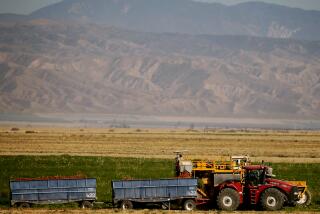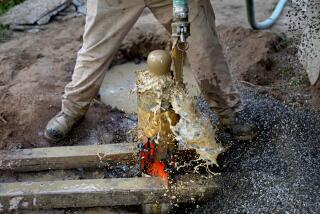Stars Sought Divining Intervention
- Share via
He could feel the pull and power of the water that lay beneath the Conejo Valley’s arid fields. And with a piece of wire, Gene “Pappy” Dyke led ranchers, farmers and the movie stars who were settling in the community to the water they needed.
Before the advent of modern water districts, “witchers” and “diviners” helped early residents locate the underground rivers and lakes far below their feet.
The water was tapped and then pumped to the surface through deep shafts to supply the cattle and sheep and the people who settled in the valley.
Just about any stick would do for divining, but Dyke liked wire because wood could break and leave him with a long walk before a suitable replacement was found.
“[The wood has] got to be green is all,” said Dyke, 82. “But I do it with a wire now, it works the same. If you go to locate water, and you’re walking across a big ranch, you’ll break the stick. It’ll twist off, it’ll twist in two.”
Finding the water was always a natural. Drilling the well, another matter.
No matter the depth of the well, the interior makeup of the valley was generally the same: basalt, called blue or green rock or granite by some, and the “hubs of hell” by others; and shale, a mix of clay and mud in a finely stratified rock structure. For Dyke, it was like drilling into a bucket of wet cement.
Then there was the matter of getting his customers to take his advice about where to dig the wells.
One was Alan Ladd, one of the most popular and handsome movie stars of his day.
“I drilled him a well in 1946. He wanted me to drill a well by the swimming pool. I checked and I said, ‘Alan, there isn’t much water here.’
“And he said, ‘Who is paying for this?’
“I said, ‘You are.’
“ ‘By God, put it where I want it!’ ”
Unknown to Dyke, Ladd told his foreman to let Dyke pick the next spot if the original was dry. Ladd did trust the driller enough to let him have his way if the poolside spot was dry. And it was, just as Dyke had said. He located a new position for Ladd’s well and brought up 75 gallons a minute. The famous leading man was a good guy, Dyke said.
“Alan just loved to talk to us guys. He’d come down to where we were working and would eat his lunch with us.”
Dyke’s other favorite was Joel McCrea. He did a lot of work at the McCrea ranch, which stands at the foot of the Norwegian Grade, about two miles off the road. Dyke’s crew was working on a water line on the street one day when McCrea got an offer.
“They’d come after him to make ‘The Virginian,’ the picture. He was out with us, and they sent the foreman after him. He rode back to the house, then came back out to us and said, ‘Well boys, if I take this job, we’ll run this water to the house.’
“And he did.”
Dyke took his well drilling rig to a wild assortment of Hollywood stars and other entertainment moguls who were building ranches and spreads throughout the foothills and valleys of Ventura County and along the coast. He was, in essence, the “water wizard” to the stars.
“I drilled wells for George Brent, Will Rogers, Sophia Loren, Eve Arden, Richard Widmark, Robert Wagner and Dick Powell.”
He remembered drilling wells for Fibber McGee, of the famous Fibber McGee and Molly radio show. Dyke found water for Bob Hope, Carol Channing, Bing Cosby, Bobby Vinton and Ronald Reagan, when he was a movie star.
He found himself sitting around drinking coffee with Channing on the bumper of a pickup truck, or chatting with Loren about her problems in Italy.
But operating a rig was hard and unforgiving work. Dyke broke his right leg twice, his pelvis once, and “came awful near to getting killed two or three times on that rig.” The rig did claim his brother, Rich, in 1948.
Sometimes wells had to be drilled all at once, no stops, because of material collapsing on the shaft.
“You have to run 24 hours a day. Say you just quit at night and go home. You’d have 75 foot of hole filled up in the morning. Caved in, cause that’s that loose shale. And it would take you all day to clean it out and make 25 feet. So we would drill around the clock. If you think that’s easy, you ought to try it for about three months straight.”
If anybody could handle a job like that, it was Dyke.
‘You’ve got to be on your toes, cause you’re swinging things around there that weigh 3,000 pounds. I didn’t know how stout I was. I picked up a 7-by-9 railroad tie, they’re 8 feet long. I don’t know how much they weigh, but it takes a pretty good man to get one on his shoulder. I could do that when I was 14 years old.”
With that strength he drilled wells for the new state freeway construction project through town, highway 101. He located a dandy for the Seventh Day Adventist Academy, getting 129 gallons a minute, and drilled 30 wells for the McMahon Ranch in Hidden Valley alone. Dyke knows where water runs at 800 gallons a minute, where it runs at 1,500 gallons a minute and if its going to be sweet or sulfur.
When he started in the 1940s, he often found water just 100 feet down. After years of supplying the ranches with irrigation, the huge lake underneath the valley began to shrink. When Dyke retired in 1985, he was drilling to 800 feet in some cases in his quest for good water.
Although retired, Dyke still uses his talent to locate water for the people who believe in the lost art of divining for water. But the demand for witchers and drillers isn’t what it used to be. He devotes much of his energy to the Thousand Oaks Elks Lodge, donating his time and effort to help a wide variety of charities in the Conejo Valley, including a crippled children’s fund; sponsorship of Girl Scouts and Boy Scouts; and support programs for senior citizens and veterans.
(BEGIN TEXT OF INFOBOX / INFOGRAPHIC)
Four years ago, a group of Thousand Oaks residents launched an oral history project to preserve the memories of the Conejo Valley’s earliest settlers. With support from the Thousand Oaks Library Foundation, dozens of residents were interviewed and their remembrances transcribed and filed at the library. Tina Carlson, who heads the project, has pared down some of the interviews, and provided them to The Times to publish in connection with Conejo Valley Days. Today, through the voice of Gene “Pappy” Dyke, 82, she tells of the early “diviners” who used a rod to find water in the semiarid valley.
More to Read
Sign up for Essential California
The most important California stories and recommendations in your inbox every morning.
You may occasionally receive promotional content from the Los Angeles Times.













